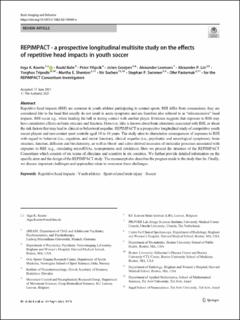| dc.contributor.author | Koerte, Inga K. | |
| dc.contributor.author | Bahr, Roald | |
| dc.contributor.author | Filipcik, Peter | |
| dc.contributor.author | Gooijers, Jolien | |
| dc.contributor.author | Leemans, Alexander | |
| dc.contributor.author | Lin, Alexander P. | |
| dc.contributor.author | Tripodis, Yorghos | |
| dc.contributor.author | Sochen, Nir | |
| dc.contributor.author | Swinnen, Stephan P. | |
| dc.contributor.author | Pasternak, Ofer | |
| dc.contributor.author | Shenton, Martha E. | |
| dc.date.accessioned | 2022-03-22T20:54:22Z | |
| dc.date.available | 2022-03-22T20:54:22Z | |
| dc.date.created | 2022-01-14T11:24:50Z | |
| dc.date.issued | 2022 | |
| dc.identifier.citation | Brain Imaging and Behavior. 2022, 16(1), Side 492-502. | en_US |
| dc.identifier.issn | 1931-7557 | |
| dc.identifier.uri | https://hdl.handle.net/11250/2986915 | |
| dc.description | This article is licensed under a Creative Commons Attribution 4.0 International License, which permits use, sharing,adaptation, distribution and reproduction in any medium or format, as long as you give appropriate credit to the original author(s) and the source, provide a link to the Creative Commons licence, and indicate if changes were made. The images or other third party material in this article are included in the article's Creative Commons licence, unless indicated otherwise in a credit line to the material. If material is not included in the article's Creative Commons licence and your intended use is not permitted by statutory regulation or exceeds the permitted use, you will need to obtain permission directly from the copyright holder. | en_US |
| dc.description.abstract | Repetitive head impacts (RHI) are common in youth athletes participating in contact sports. RHI differ from concussions; they are considered hits to the head that usually do not result in acute symptoms and are therefore also referred to as “subconcussive” head impacts. RHI occur e.g., when heading the ball or during contact with another player. Evidence suggests that exposure to RHI may have cumulative effects on brain structure and function. However, little is known about brain alterations associated with RHI, or about the risk factors that may lead to clinical or behavioral sequelae. REPIMPACT is a prospective longitudinal study of competitive youth soccer players and non-contact sport controls aged 14 to 16 years. The study aims to characterize consequences of exposure to RHI with regard to behavior (i.e., cognition, and motor function), clinical sequelae (i.e., psychiatric and neurological symptoms), brain structure, function, diffusion and biochemistry, as well as blood- and saliva-derived measures of molecular processes associated with exposure to RHI (e.g., circulating microRNAs, neuroproteins and cytokines). Here we present the structure of the REPIMPACT Consortium which consists of six teams of clinicians and scientists in six countries. We further provide detailed information on the specific aims and the design of the REPIMPACT study. The manuscript also describes the progress made in the study thus far. Finally, we discuss important challenges and approaches taken to overcome these challenges. | en_US |
| dc.language.iso | eng | en_US |
| dc.subject | repetitive head impacts | en_US |
| dc.subject | soccer | en_US |
| dc.subject | sport-related brain injury | en_US |
| dc.subject | youth athletes | en_US |
| dc.title | REPIMPACT: A prospective longitudinal multisite study on the effects of repetitive head impacts in youth soccer | en_US |
| dc.type | Peer reviewed | en_US |
| dc.type | Journal article | en_US |
| dc.description.version | publishedVersion | en_US |
| dc.rights.holder | © The Author(s) 2021 | en_US |
| dc.source.pagenumber | 492-502 | en_US |
| dc.source.volume | 16 | en_US |
| dc.source.journal | Brain Imaging and Behavior | en_US |
| dc.source.issue | 1 | en_US |
| dc.identifier.doi | 10.1007/s11682-021-00484-x | |
| dc.identifier.cristin | 1981070 | |
| dc.description.localcode | Institutt for idrettsmedisinske fag / Department of Sports Medicine | en_US |
| cristin.ispublished | true | |
| cristin.fulltext | original | |
| cristin.qualitycode | 1 | |
